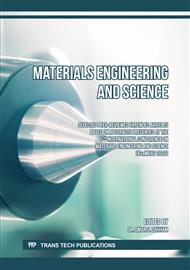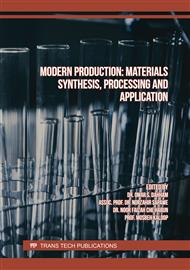[1]
M. D. Kiran, H. K. Govindaraju, and T. Jayaraju, Evaluation of Mechanical Properties of Glass Fiber Reinforced Epoxy Polymer Composites with Alumina, Titanium dioxide and Silicon Carbide, volume 5, no. 10, 2018, pages 22355-22361.
DOI: 10.1016/j.matpr.2018.06.602
Google Scholar
[2]
R. A. Kumar, A. Devaraju, and S. Arunkumar, Experimental Investigation on Mechanical Behaviour and Wear Parameters of TiC and Graphite Reinforced Aluminium Hybrid Composites, Mater. Today Proc., volume 5, no. 6, 2018, pages 14244-14251.
DOI: 10.1016/j.matpr.2018.03.005
Google Scholar
[3]
T. Harifi and M. Montazer, Photo-, bio-, and magneto-active colored polyester fabric with hydrophobic/hydrophilic and enhanced mechanical properties through synthesis of TiO2/Fe3O4/Ag nanocomposite, Ind. Eng. Chem. Res., volume 53, no. 3, 2014, pages 1119-1129.
DOI: 10.1021/ie403052m
Google Scholar
[4]
F. Liu, S. Deng, and J. Zhang, Mechanical Properties of Epoxy and Its Carbon Fiber Composites Modified by Nanoparticles, J. Nanomater., volume 2017, 2017, pp.14-16.
Google Scholar
[5]
X. Wang, W. Xing, P. Zhang, L. Song, H. Yang, and Y. Hu, Covalent functionalization of graphene with organosilane and its use as a reinforcement in epoxy composites, Compos. Sci. Technol., volume 72, no. 6, 2012, pages 737-743.
DOI: 10.1016/j.compscitech.2012.01.027
Google Scholar
[6]
M. Y. Shen et al., Mechanical properties and tensile fatigue of graphene nanoplatelets reinforced polymer nanocomposites, J. Nanomater., volume 2013, (2013).
Google Scholar
[7]
C. Bora, P. Gogoi, S. Baglari, and S. K. Dolui, Preparation of polyester resin/graphene oxide nanocomposite with improved mechanical strength, J. Appl. Polym. Sci., volume 129, no. 6, 2013, pages 3432-3438.
DOI: 10.1002/app.39068
Google Scholar
[8]
D. Hou et al., Reactive molecular dynamics and experimental study of graphene-cement composites: Structure, dynamics and reinforcement mechanisms, Carbon N. Y., volume 115, 2017, pages 188-208.
DOI: 10.1016/j.carbon.2017.01.013
Google Scholar
[9]
M. Rafiee, S. H. Rad, F. Nitzsche, J. Laliberte, and M. R. Labrosse, Significant fatigue life enhancement in multiscale doubly-modified fiber/epoxy nanocomposites with graphene nanoplatelets and reduced-graphene oxide, Polymers (Basel)., volume 12, no. 9, (2020).
DOI: 10.3390/polym12092135
Google Scholar
[10]
A. Khabaz-Aghdam, B. Behjat, L. F. M. da Silva, and E. A. S. Marques, A new theoretical creep model of an epoxy-graphene composite based on experimental investigation: effect of graphene content, J. Compos. Mater., volume 54, no. 18, 2020, pages 2461–2472.
DOI: 10.1177/0021998319895806
Google Scholar



